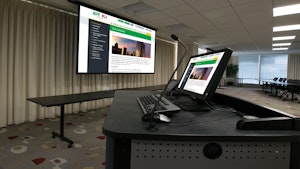Access to conference rooms provides organizations the ability to discuss important business topics among staff, partners or customers. Sharing ideas and collaborating resources enable companies to innovate products, refine processes and engage key personnel. Having an audio system in place to accurately and effectively give everyone a clear voice in meetings is crucial. Background noise, microphone interference, and audio “dead zones” significantly dilute the productivity of a meeting. Below are several considerations to think about when planning your conference room build-outs.
 Size and Location of Conference Rooms
Size and Location of Conference Rooms
Before building out your conference room area, you’ll need to consider how many people it will fit. Also, you’ll need to consider how the seating is arranged and positioned. In addition to the size of the room, considerations for the location is crucial as well. Will the room be in a location with minimal background noise (usually preferred)? Microphones and audio systems can pick up the slightest noises. Even though most of today’s audio systems can filter out background noise, it is still best practice to naturally minimize as much background noise and interference as possible.
Audio System Capabilities for Conference Rooms
Technological advances in audio distribution and synthesizing have enabled Audio/Video designers to implement smaller, less invasive hardware in conference rooms.
Gooseneck Microphones:
Having a large conference room seating 50 or over 100 participants present many challenges for audio distribution and synthesizing. The most practical solution for this scenario is to install Gooseneck microphones at every seat. The pros of this approach entail that installation is quick and everyone’s microphone individually adjusts for optimal audio distribution. Microphones such as Shure’s CVG18 comes with “CommShield Technology” to help protect against unwanted RF signals from smartphones and other devices. The drawback for Gooseneck microphones is the level of invasiveness and the amount of table space used.
Boundary Microphones:
The main benefit of having Boundary microphones is they can be programmed to pick up audio clearly in a 360-degree field. Less invasive than Gooseneck microphones, they take up significantly less table space. Boundary microphones can be placed on top of a conference table or they can be embedded. Shure’s Microflex Multi-Element Boundary microphone has a coverage area of 300 degrees (end of the table), 360 degrees or a bi-directional. In addition, it comes with a programmable mute switch, custom light colors and CommShield Technology.
Speaker Phones:
Smaller conference room designs, such as huddle spaces, often utilize a singular speaker phone that ties into VoIP. Speaker phones in use today are capable, and now intelligent enough to work alongside your smart phone with some pretty cool integrations. Most speakerphones have color touch screens, and generally, employ 360-degree microphones just like the Boundary mics we talked about before. Polycom’s RealPresence Trio 8800 has touchscreen capability and amazing audio quality. In addition, the Trio 8800 has the ability to share HD content from a Bring Your Own Device (BYOD) platform.
Ceiling Microphones:
Just like the name implies, Ceiling microphones mount to or embed in the ceiling of a conference room. With either fixed ceilings or drop ceilings, these mics perform great for picking up an entire room without unnecessary clutter and wires on lining your tabletop. For large conference rooms, one mic might not be enough. In that case, multiple mics can be mounted from the ceiling across the room to pick every single voice. These mics have the capability of 360-degree audio pick up and are best for medium to large sized conference rooms. Shure’s Microflex Advanced Ceiling Array provides an intuitive user interface for microphone attributes including lobe configuration, automatic mix settings, and preset templates. It integrates seamlessly with Dante™ Networked Audio, and third-party preset controllers including Crestron and AMX, delivering a high-quality AV Conferencing experience and an aesthetically pleasing and productive meeting space.
 More Information for Audio Optimization in Conference Rooms
More Information for Audio Optimization in Conference Rooms
Strategic Communications has been a trusted Audio Video and IT integrator for over 24 years. For more information on Audio Video solutions for conference rooms please click here to be directed to Strategic’s AV page. You can also contact us at www.yourstrategic.com/contact-us to speak with one of our Audio Video experts!
Share this Post

